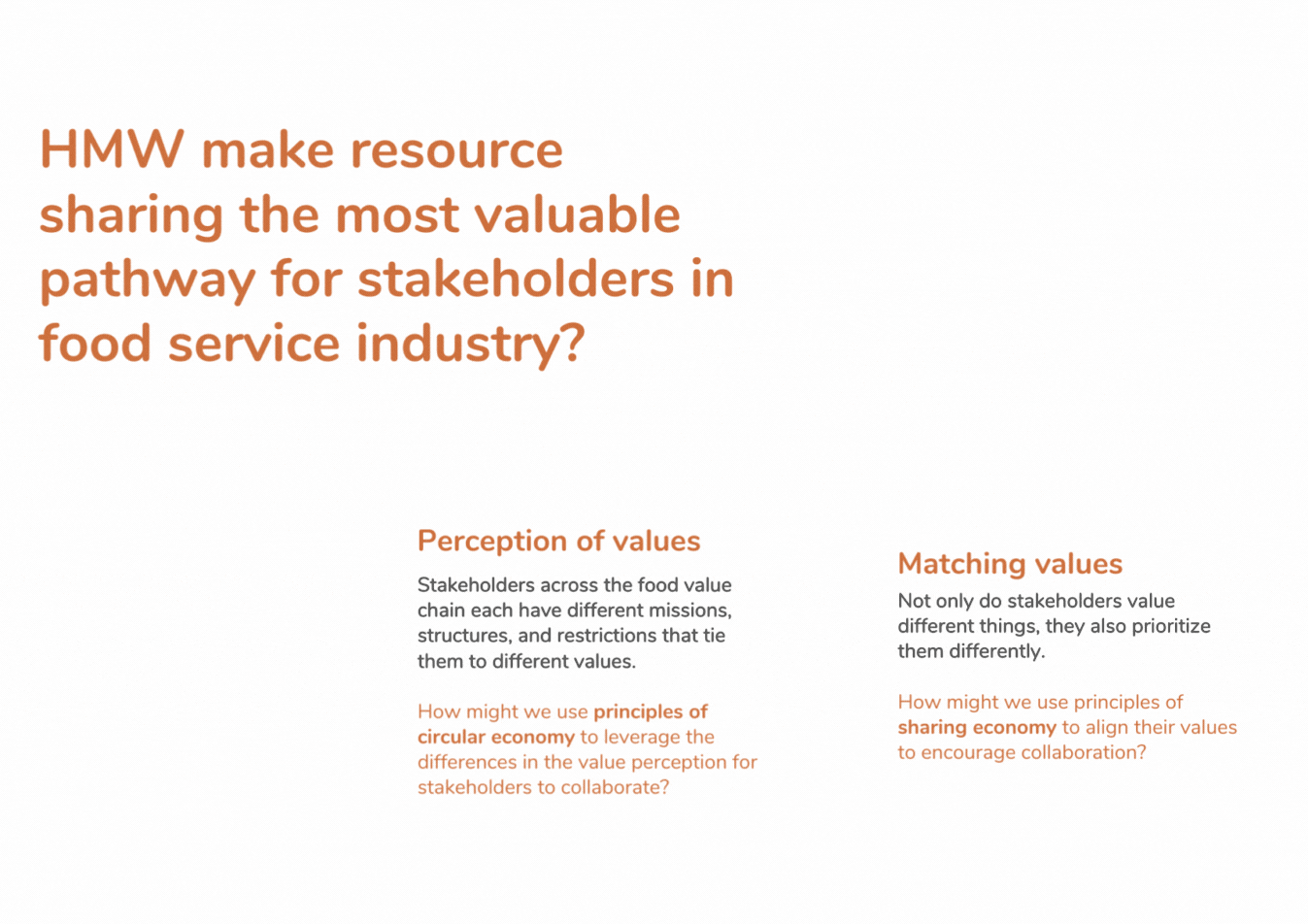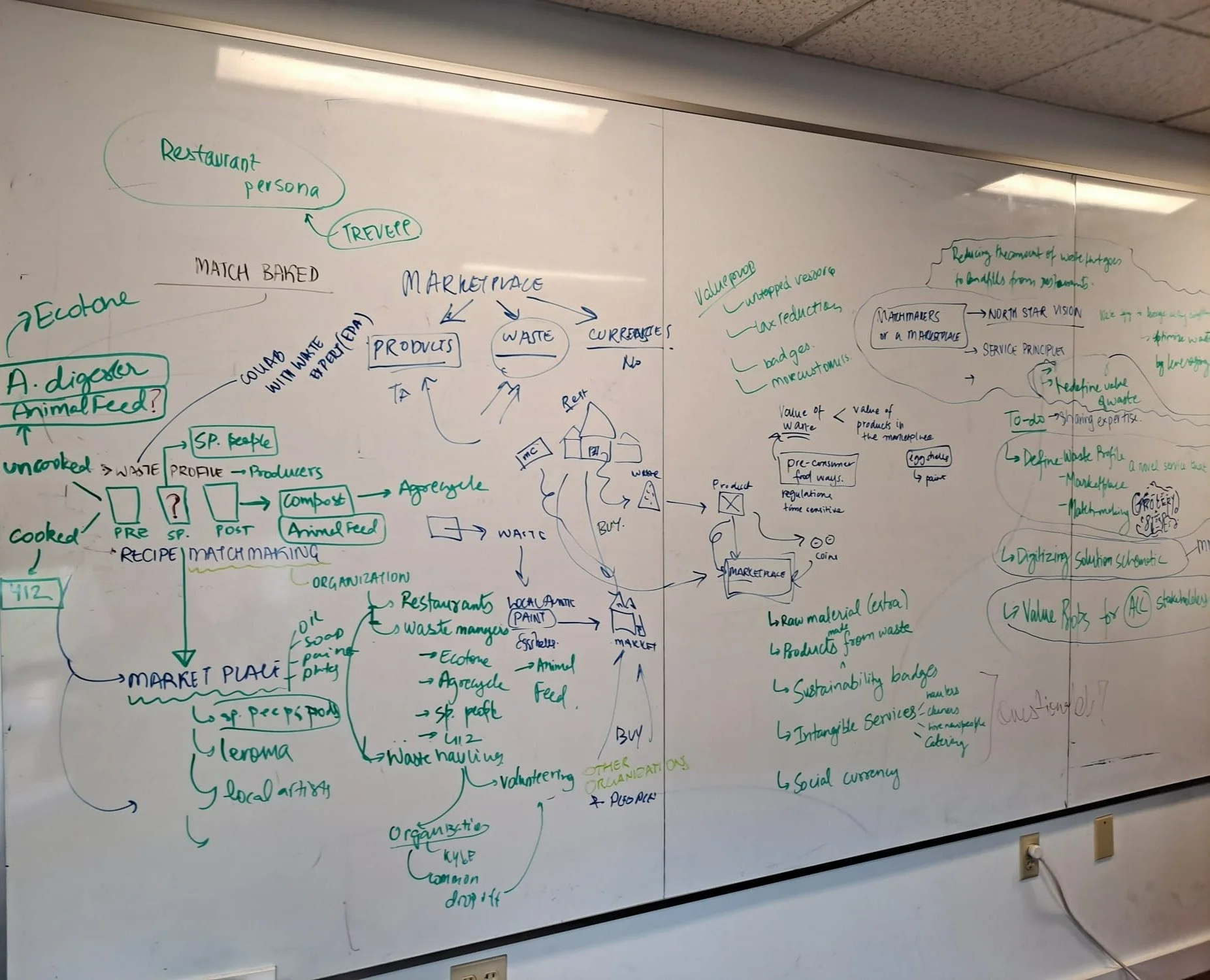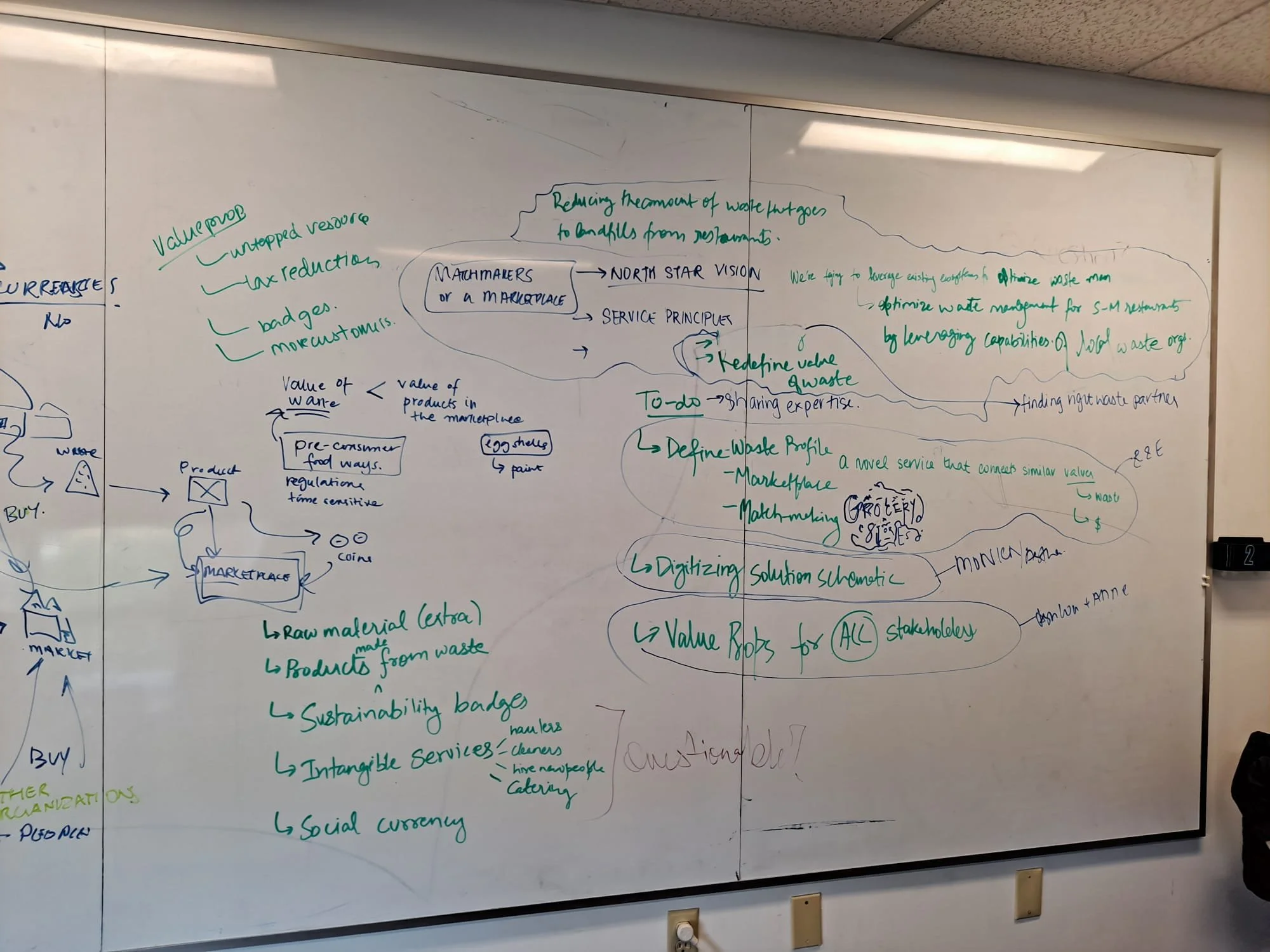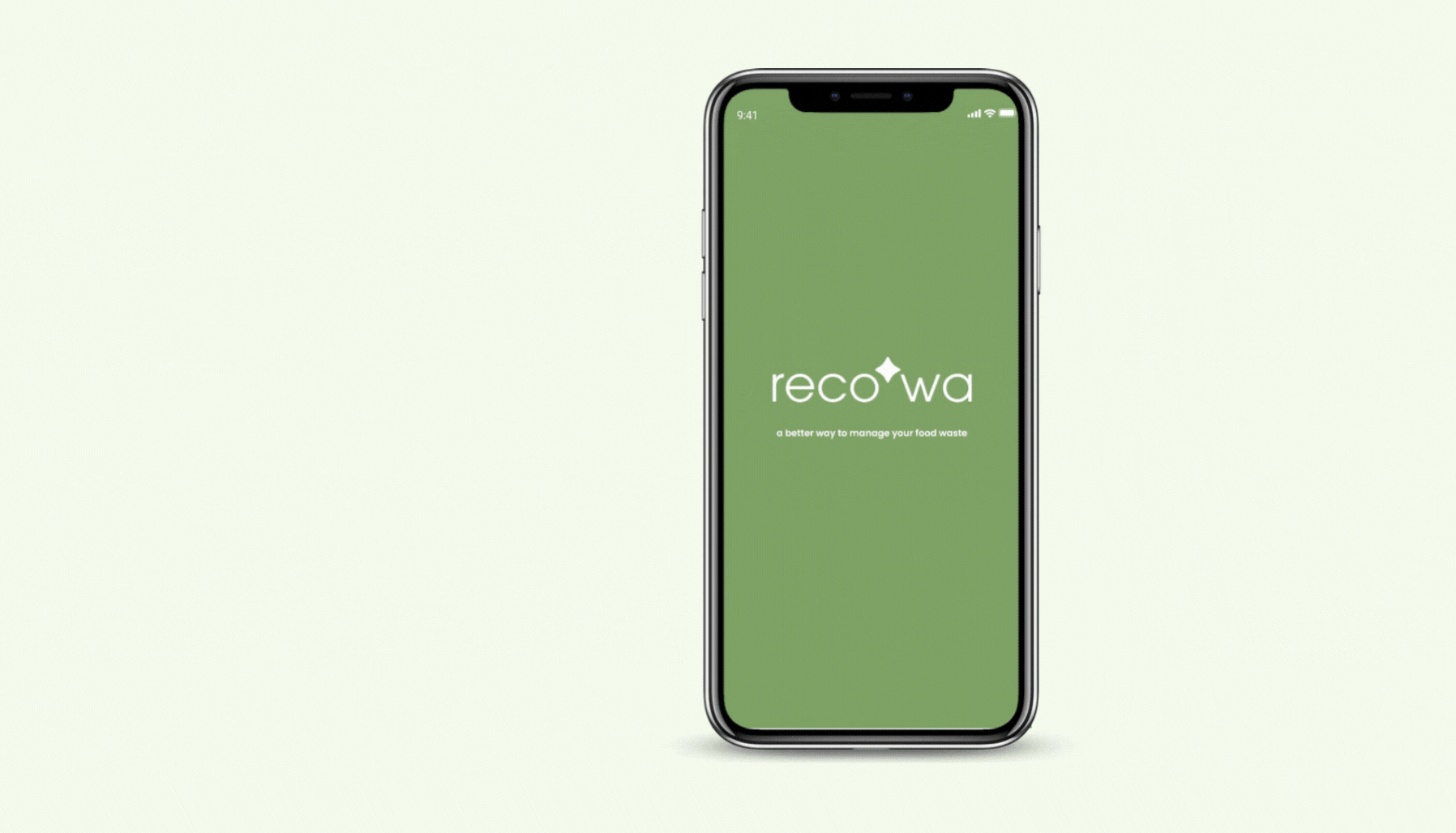
A service that unites peers to deliver positive social impact and that is planet-positive
OVERVIEW
The Student Service Design Challenge is a global design award that celebrates, encourages and inspires the next generation of designers. The prompt in 2022 encouraged students to “design a people-centric and planet-positive service that uses principles of circular design “
Our team focused on creating a service that prevents and redirects food waste to prevent it from ending up in landfills.
Tags: UX Design, User Research
Project Time: 5 Months
Team: Anne Milan, Ashlon Frank, Astha Vagadia Elisa Arango, Raghvi Kabra
My Role: User Research, UX Design
Impact: Honorable Mention Phillips Service Design Challenge Top 8 out of 90 worldwide entries, Top 12 selected entries to pitch at the Dragon’s Den in Barcelona Design Week, Bringing the service idea to reality with Design for America

Food Waste
PROBLEM
1/3 of food produced for human consumption, about 1.3 billion tonnes is lost or wasted globally every year. Food waste alone contributes towards 10% of green house gas emissions.

OPPORTUNITY GAP IDENTIFED
How might we make resource sharing the most valuable pathway for stakeholders in the food service industry?
Recowa: A matchmaking service that connects producers of food waste to consumers (waste diverters and transformers) in the local ecosystem to prevent food from ending up in landfills.
OUR SOLUTION
Get matched with local food diverters and transformers that work best for you!
Each restaurant has a unique food waste profile, recowa takes into account the type of food waste your restaurant generates to match you with suitable partners locally.
Matching also takes into account location and pairs you with similar restaurants nearby to schedule a group pick-up.
Incentives to close the loop
Successfully diverted food waste from landfills earns your restaurant
points that can be utilized in the recowa marketplace.
Badges indicate your restaurant's sustainability levels that can be used to qualify your restaurant for tax breaks and shared with consumers to help them eat at sustainable businesses..
PROCESS
How did we get here?
The competition was split into 4 phases that guided our process

The goal of this round was to explore the current ownership-oriented economy, identify potential local opportunities, and come up with a design proposal.
IDENITFY & EXPLORE
PHASE 2
Our food system is highly complex, it intersects with almost every other natural and built system, we started our research by mapping the stakeholders, processes, and flow. Then we took a granular approach by looking at food wastage in Pittsburgh. We created a gigamap to highlight community-led initiatives and organizations.
Understanding food waste
EXPLORE
UNDERSTANDING EXISTING SERVICES
Not a lack of solutions but a lack of interconnectedness and scalability
We focused on the local system in the city of Pittsburgh and identified the key players, organizations, and community-led initiatives in the space.
Through secondary research and interviews with 3 experts in the food sector, we were able to visualize the complexity of the system and begin to see the gaps and obstacles that are not being addressed.
We realized that the problem isn’t a lack of solutions to reduce food waste but rather a lack of interconnectedness and scalability.

OPPORTUNITY?
a sustainable service that supports locally available solutions to share resources and builds capacity to reduce food waste across the food value chain
There was still lots to uncover, our phase 1 opporunity only served as a direction for further research, we further refined our service and narrowed down to our target users in the subsequents stages of the competition.
From our research in phase 1 we decided to focus on building partnernsips to avoid re-inventing the wheel, our proposal was:

EMPATHIZE AND DISCOVER
PHASE 2
The goal of this round was to discover all the stakeholders and learn to empathize with them.
EXPLORE
Diverging from our area of focus
At the end of phase 1, our area of focus was towards ‘resource sharing’ to gain more information we split our research into two pathways:
Exploration of Multi-Stakeholder partnerships: This research helped us identify potential challenges and opportunities for partnerships in the food industry.
Understanding the ‘value’ of food: This research helped us identify the value food had at each stage in its life cycle which then helped us create connections between organizations working towards food recovery or food waste transformation at each stage.
Interviews with stakeholders highlighted the challenges and existing processes
DISCOVER
We reached out to local experts and people involved in food rescues and managing food waste. The highlights from these discussions are as follows:
Connecting the lifecycle of food with recovery pathways at each stage
UNDERSTANDING RECOVERY
Our research into local organizations and process helped us map how food can be recovered at each stage of its ‘life’.
TAKEAWAYS
At the end of this phase our observations led us to three key insights that helped further refine our problem statement.

The goal at this stage was to synthesize the information from the discovery phase. We worked to identify the gaps, challenges, and patterns in the maps of the current situation and translate these into themes.
Our objective was to re-write our initial design proposal by creating a more focused challenge- or needs statement
FRAME & DEFINE
PHASE 3
Identifying small restaurant owners as our target users
FRAMING
We noticed that in the food value chain, restaurants are uniquely placed in a way that connects them to multiple stakeholders- distributors, suppliers, consumers, the hospitality industry, waste haulers, and waste managers, making them a great starting point for understanding and managing the waste they create.
Not only are restaurants uniquely intertwined with so many different stakeholders in the food value chain, they are also huge contributors of waste. In fact, data shows that after households, consumer-facing industries, including restaurants, are responsible for the largest generation of food waste, 43% to be precise.
USER INTERVIEWS AND INSIGHTS
We interviewed several restaurant owners in Pittsburgh and sent out surveys to gauge current food waste practices, the highlights from this research are:
Themes begin to emerge
We mapped the relationship between organizations and identified three overarching values: People, Planet and Profit. This map helped us identify valuable pathways for stakeholders to share resources, and used as drivers to foster collaboration.
Organizations operating to recover food can be classified into 5 categories in descending order of their impact; source reduction, feeding hungry people, feeding animals, converting waste to recover energy, and composting.
For example, if we look at 412 food rescue, we identified Planet and People as two key values. Their motivation for managing food insecurity and food loss is ultimately satisfying the pathway of feeding people.
Identifying valuable pathways for stakeholders to share resources
VALUE MAPPING
After clustering our findings and affinity mapping our different opportunities we framed our problem as the following:
Refining our proposal
DEFINE

IDEATE & DEVELOP
PHASE 4
This is was our final round! After framing the problem, we began to think of solutions and validate our concept with our stakeholders.
BRAINSTROMING
How do we connect our stakeholders and align values?
Synthesizing all of our findings we began to brainstorm concepts, the challenge was in building a service that would connect all of our stakeholders in a way where each finds value in the partnership.
IDEATING
Developing our concept
we used a creative matrix to help us synthesize our ideas from the brainstorming phase. From this session, the theme matchmaking emerged. We used matchmaking as a way to align the right stakeholders with one another.
REFINE
with the preliminary idea in place, we began mapping how the service would work. We started with the restaurants, they typically had three types of waste 1. Pre-consumer 2. Post-consumer and Special food waste. we mapped pathways for each type of waste, linking them with our organization. From this stage, it became easier to see how our service fit into the web of stakeholders ensuring their needs were met.
Creating the service model
preliminary service map
refined service map
Restaurant owners have a hard time managing their food waste, and a service like Recowa would be helpful
VALIDATE
We were able to validate our service concept through interviews with 3 restaurant owners. These discussions helped us identify any gaps in our service design and also helped us understand the viability of turning our service into a business.

FINAL DESIGN
The final submission deck:
The final service developed comprises of an app that uses a matchmaking algorithm to pair restaurants with the right organization based on the type and volume of the food waste they generate.
The service uses three components
Waste profile: the waste profile quantifies the pre-consumer, post-consumer, and special waste by quantity and type
Matchmaking algorithm: Using the waste profile generated the algorithm singles our the best pathways for the food waste.
Marketplace: Redefines the value of food waste.

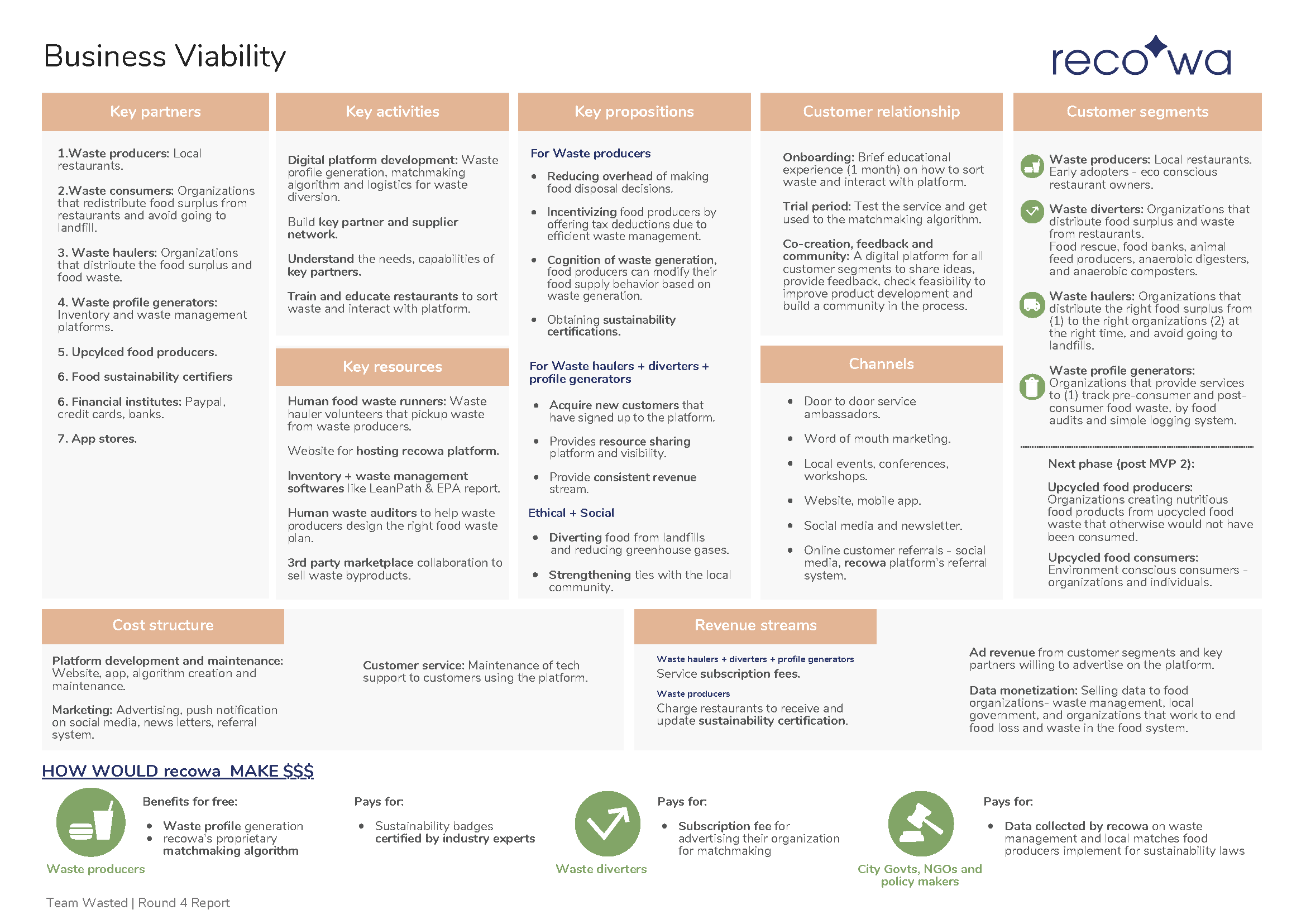
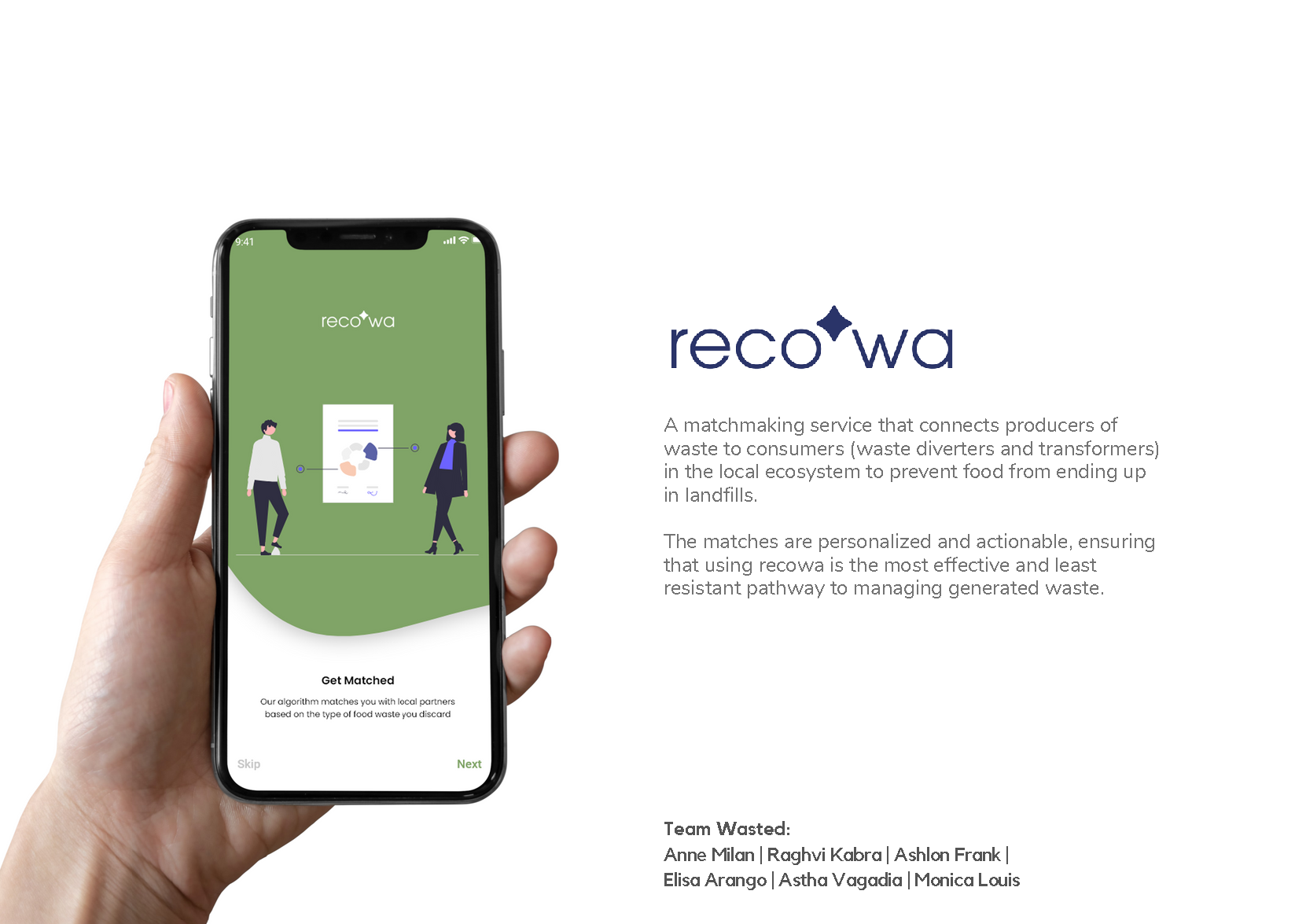
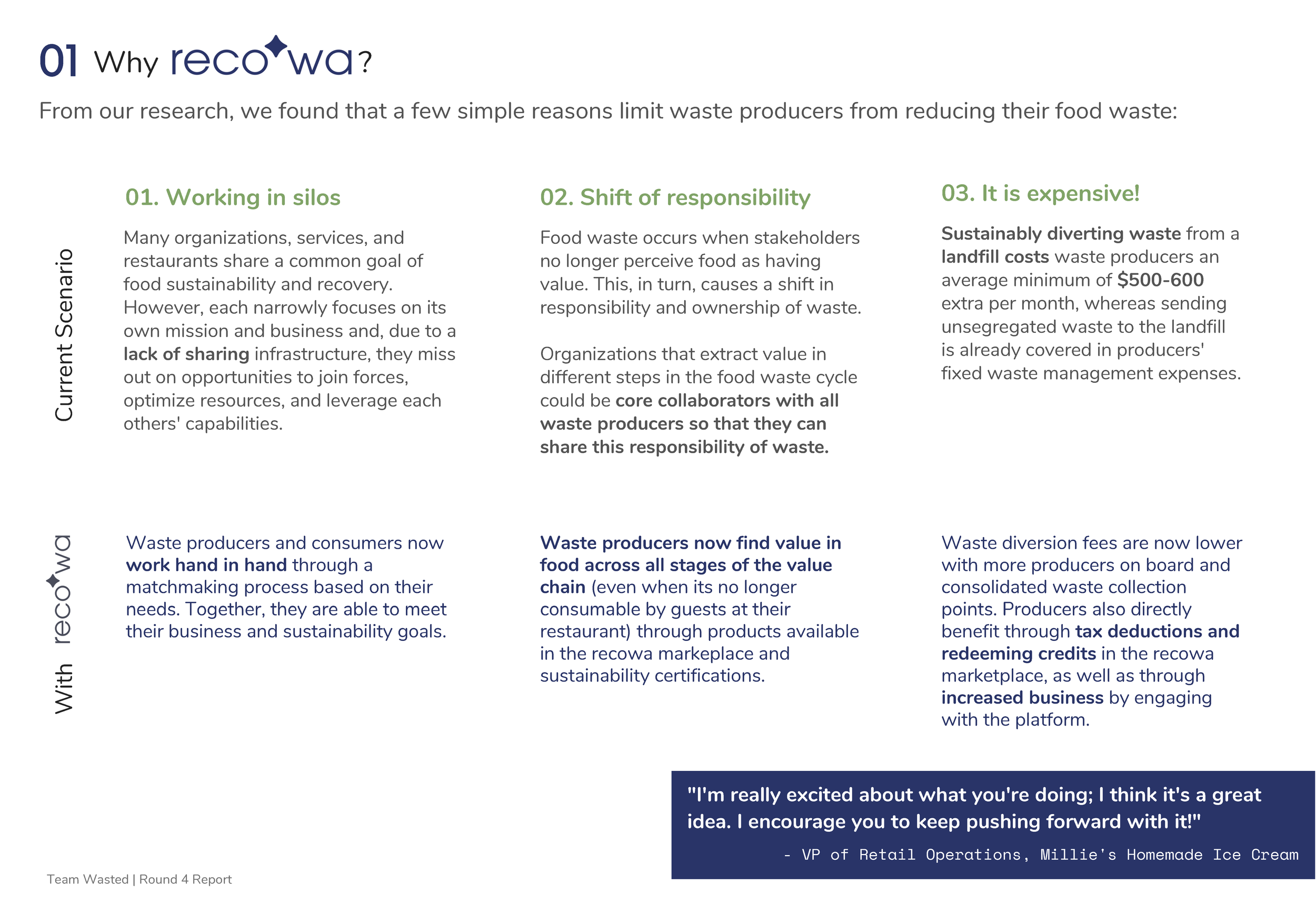


REFLECTION
What I learned..
Although we designed an app to address the service design challenge, it's important to recognize that the solution involved more than just app design. Participating in this competition introduced me to new methodologies and skills, particularly the importance of effective communication among stakeholders and the need to prioritize their goals. I want to express my gratitude to Frank Kolman, our mentor since phase 2, whose perspective was instrumental in aligning our service strategies with the business model.
















